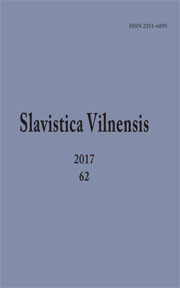Рукописный кириллический аллигат в составе чешского латиноязычного конволюта Hareticorum armatura из библиотеки Пражского метропольного капитула св. Вита как возможный след Ф. Скорины
A Cyrillic Manuscript Appendix, Part of the Czech-Latin Volume Hareticorum armatura from the Library of the Metropolitan Chapter of St. Vitus in Prague, as a Possible Trace of F. Skaryna
Author(s): Ilja LemeškinasSubject(s): Cultural history, Historical Linguistics, 15th Century, 16th Century, Theory of Literature
Published by: Vilniaus Universiteto Leidykla
Keywords: cyrillic manuscript appendix; Czech-Latin volume; metropolitan chapter of St. Vitus in Prague; recipe of ink; register of numerals; F. Skaryna;
Summary/Abstract: This article deals with the manuscript codex from the first half of the 16th century Hareticorum armatura (archive: Archiv Pražského hradu, collection: Knihovna Metropolitní kapituly u sv. Víta, sign. D.118), which is composed mostly of texts written in Latin and Czech. There is also a passage (Fig. 136–139) written in Old Russian with the Cyrillic script. On the flyleaf of the book, a record of its owner Liber mgri Johannis Hertemberger de Cubito can be found, which indicates that the book was being kept in the library of the Saint Vitus chapter (Jan Herttemberger z Lokte was the canon of the Saint Vitus chapter between 1480-1498) from the end of the 15th century. Analysis of the book reveals a possibility that later, at the beginning of the 16th century or in the first half of the 16th century, another compilation was added to Jan Herttemberger’s volume, which contained a Cyrillic source. The fact, that the Old Russian manuscript was attached to the predominantly Latin codex, was apparently predetermined by practical thinking. The Cyrillic booklet was made of solid paper and as such could reinforce the seam line (binding) of the Latin book. The Cyrillic text contains Latin glosses; in turn, the Latin text (Poggi Florentini ad Leonardum Aretinum epistola de morte Hieronymi Pragensis, f. 169v–175v) contains a Cyrillic note , which is to be found in the margins on f. 174v. These features indicate that the compiler or the owner of the codex was a literate Catholic of the first half of the 16th century, who mastered writing in Cyrillic script and knew Old Russian. Of
Journal: Slavistica Vilnensis
- Issue Year: 62/2017
- Issue No: -
- Page Range: 43-64
- Page Count: 22
- Language: Russian

